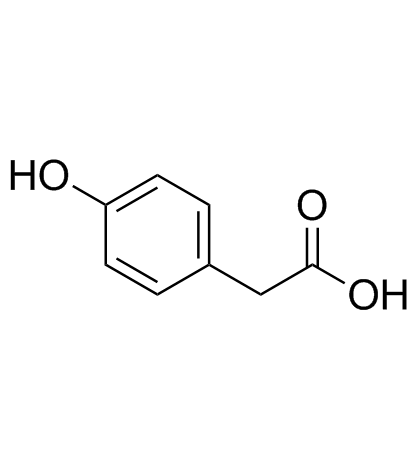4-Hydroxyphenylacetic acid

4-Hydroxyphenylacetic acid structure
|
Common Name | 4-Hydroxyphenylacetic acid | ||
|---|---|---|---|---|
| CAS Number | 156-38-7 | Molecular Weight | 152.147 | |
| Density | 1.3±0.1 g/cm3 | Boiling Point | 346.6±17.0 °C at 760 mmHg | |
| Molecular Formula | C8H8O3 | Melting Point | 148-151 °C(lit.) | |
| MSDS | USA | Flash Point | 177.6±17.4 °C | |
| Symbol |

GHS07 |
Signal Word | Warning | |
|
HMDB: a knowledgebase for the human metabolome.
Nucleic Acids Res. 37(Database issue) , D603-10, (2009) The Human Metabolome Database (HMDB, http://www.hmdb.ca) is a richly annotated resource that is designed to address the broad needs of biochemists, clinical chemists, physicians, medical geneticists, nutritionists and members of the metabolomics community. Si... |
|
|
Age-related reference values for urinary organic acids in a healthy Turkish pediatric population.
Clin. Chem. 40(6) , 862-6, (1994) Organic acid concentrations were quantified by gas chromatography and the individual acids identified by mass spectrometry in urine specimens from a healthy Turkish pediatric population of ages 2 days to 16 years, subdivided into five age groups. We quantifie... |
|
|
Prediction of skeletal muscle and fat mass in patients with advanced cancer using a metabolomic approach.
J. Nutr. 142(1) , 14-21, (2012) Urine and plasma metabolites originate from endogenous metabolic pathways in different organs and exogenous sources (diet). Urine and plasma were obtained from advanced cancer patients and investigated to determine if variations in lean and fat mass, dietary ... |
|
|
Ultra high performance liquid chromatography with mass spectrometry method for the simultaneous determination of phenolic constituents in honey from various floral sources using multiwalled carbon nanotubes as extraction sorbents.
J. Sep. Sci. 38 , 2597-606, (2015) An ultra high performance liquid chromatography with mass spectrometry method has been developed for the simultaneous separation, identification and determination of 22 phenolic constituents in honey from various floral sources from Yemen. Solid-phase extract... |
|
|
Metabolomic profiles delineate potential role for sarcosine in prostate cancer progression.
Nature 457(7231) , 910-4, (2009) Multiple, complex molecular events characterize cancer development and progression. Deciphering the molecular networks that distinguish organ-confined disease from metastatic disease may lead to the identification of critical biomarkers for cancer invasion an... |
|
|
A metabolite profiling approach to identify biomarkers of flavonoid intake in humans.
J. Nucl. Med. 139 , 2309-14, (2009) Flavonoids are phytochemicals that are widespread in the human diet. Despite limitations in their bioavailability, experimental and epidemiological data suggest health benefits of flavonoid consumption. Valid biomarkers of flavonoid intake may be useful for e... |
|
|
Quantitative analysis for organic acids in biological samples: batch isolation followed by gas chromatographic-mass spectrometric analysis.
Clin. Chem. 35(4) , 587-95, (1989) This new method for qualitative and quantitative determination of organic acids, aldehydes, and ketones in biological samples is effective for use with urine, plasma, and amniotic fluid, and it requires no deproteinization. Isolation by batch-wise liquid part... |
|
|
Urinary and plasma organic acids and amino acids in chronic fatigue syndrome.
Clin. Chim. Acta 361(1-2) , 150-8, (2005) Previous work by others have suggested the occurrence of one or more chemical or metabolic 'markers' for ME/CFS including specific amino acids and organic acids and a number of unidentified compounds (CFSUM1, CFSUM2). We have shown elsewhere that CFSUM1 is pa... |
|
|
SPE-NMR metabolite sub-profiling of urine.
Anal. Bioanal. Chem 404(8) , 2349-61, (2012) NMR-based metabolite profiling of urine is a fast and reproducible method for detection of numerous metabolites with diverse chemical properties. However, signal overlap in the (1)H NMR profiles of human urine may hamper quantification and identification of m... |
|
|
Detection of autosomal dominant polycystic kidney disease by NMR spectroscopic fingerprinting of urine.
Kidney Int. 79(11) , 1244-53, (2011) Autosomal dominant polycystic kidney disease (ADPKD) is a frequent cause of kidney failure; however, urinary biomarkers for the disease are lacking. In a step towards identifying such markers, we used multidimensional-multinuclear nuclear magnetic resonance (... |